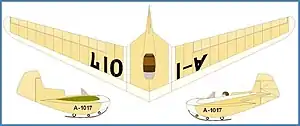Kimura HK-1
The Kimura HK-1 was a glider built in Japan in 1939 to investigate the possibilities of tailless aircraft. It was a single-seat design with an open cockpit, swept wings, and a single tail fin. The HK-1 made a total of 169 test flights between 15 December 1939 and 7 March 1940, towed aloft behind a car.
| HK-1 | |
|---|---|
 | |
| Role | Research glider |
| National origin | Japan |
| Manufacturer | Ito Airplane Works |
| Designer | Hidemasa Kimura |
| Introduction | 1939 |
| Retired | 1940 |
| Status | Cancelled |
| Number built | 1 |
| Developed into | Kayaba Ku-2 |
By this time, the glider's success had attracted the attention of the Army, which arranged to purchase the aircraft. It was taken to the Tachikawa factory for testing, but was crashed after only 13 flights, on 16 April 1940. The design proved sufficiently interesting for the Army to commission further research into the tailless concept, which would lead to the Kayaba Ku-2.
Specifications
General characteristics
- Crew: One pilot
- Length: 3.50 m (11 ft 6 in)
- Wingspan: 10.00 m (32 ft 10 in)
- Height: 1.80 m (5 ft 11 in)
- Wing area: 14.0 m2 (151 sq ft)
Performance
- Maximum speed: 85 km/h (53 mph, 46 kn)
References
Wikimedia Commons has media related to Kayaba HK-1.
- Wooldridge, E.T. "Japanese flying wings". History of the Flying Wing. Retrieved 29 April 2007.
- 日本飞翼的短暂研究 Archived 2012-02-13 at the Wayback Machine
This article is issued from Wikipedia. The text is licensed under Creative Commons - Attribution - Sharealike. Additional terms may apply for the media files.